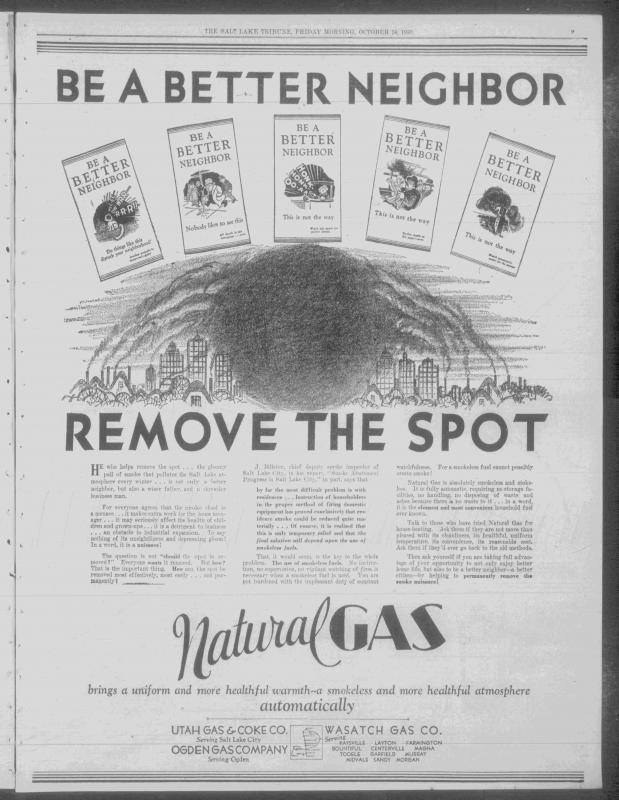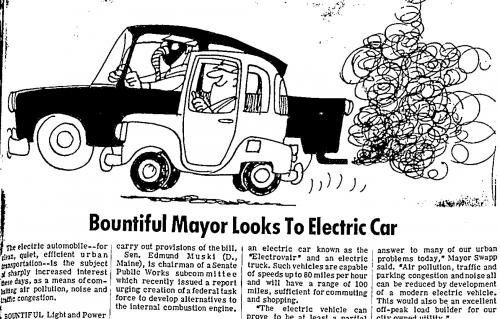Utah's Future
by Logan Mitchell, PhD Affiliate Professor of Atmospheric Science, University of Utah | Climate Scientist + Energy Analyst, Utah Clean Energy
Understanding Utah’s air quality history is important for several reasons. It provides context for where we’re at today and gives us a glimpse of Utah's air quality future. Also, knowing that Utahns have been working on this challenge for over a century gives us a sense of the immense scale of this challenge, and some measure of grace recognizing how many others have worked on it before us. George W. Snow, Chief of Salt Lake Bureau of Mechanical Inspections said it best back in 1917 in the Salt Lake Telegram:
"The city’s atmosphere can be cleared of smoke and grime, but not in a single day or year, not by a single group or group of persons, not by a single invention nor without efforts or price. There is nothing magical going to happen. It will take a properly guided, united and continued effort to solve the problem."
Since Snow’s statement over a century ago, we have made immense progress improving air quality, and while there is still a long way to go, there are reasons for renewed optimism about Utah’s air quality future.
Since the Industrial Revolution, we have been in a constant energy transition. The discovery and utilization of coal, oil, and natural gas led to transformative societal progress coupled with severe societal costs via polluted air and a rapidly warming climate. For over a century, Utahns have recognized the perils of air pollution and have utilized scientific ingenuity and innovation to adopt cleaner and more energy efficient technologies to power our lives.
The Energy Sources We Choose
In the early 1900s burning coal was often done inefficiently, and like a campfire that isn’t burning well, it led to wasted energy and clouds of visible “smoke” air pollution. There was a concerted effort, in many cases led by women community leaders, to educate Utahns on the proper operation of appliances and installing “smoke consumers,” devices that improved combustion efficiency in coal stoves. Thankfully, energy efficiency has evolved since those days! Better building insulation, double and triple pane windows, smart thermostats, and more have made our buildings more energy efficient and reduced emissions. Today we’re still working on improving building codes that will continue the long trend of energy efficiency into the future. After all, the cheapest form of energy is the energy you don’t even use.
Home heating provides another example of a past and ongoing energy transition. Natural gas was first introduced in Salt Lake City in 1930 as a “smokeless fuel” that was superior to coal and would help reduce air pollution. Initially natural gas was expensive and restricted to affluent early adopters. Fast forward 60 years later to the 1990s, and natural gas lines reached most homes in Utah and coal had virtually disappeared as a home heating fuel. Today, Utah has the highest percent of homes heated by natural gas in the country. While natural gas has lower emissions than coal, we now know that it still contributes to winter and summer air pollution and to the changing climate, especially when you consider leaks from the natural gas system that release vast quantities of methane, a potent greenhouse gas. In the past few years, improvements in heat pump technologies for space and water heating are ushering in the next phase of the residential energy transition towards all-electric homes that are affordable, comfortable, and no longer emit any air pollution.
As we continue to innovate, newer, cleaner energy sources continue to emerge and evolve. The costs of wind and solar have fallen dramatically, and they are now the cheapest way to produce energy. Regional transmission lines with spatial scales similar to large scale weather systems ensure the sun is always shining and the wind is always blowing on regional renewable energy resources. Advances in batteries, geothermal, hydrogen and nuclear in the coming years will fill out a carbon free electric system while continued advances in energy efficiency will reduce the total amount of energy we’ll need to produce.
Air Quality and Our Evolving Transportation System
Vehicles are on a similar trajectory of innovation towards zero emissions. Between 1950-1970, vehicle emissions became a dominant source of air pollution in Utah and around the world. In 1966 the Bountiful Mayor wrote an op-ed in the Davis County Clipper that predicted that electric vehicles (EVs) would be the ultimate solution to air pollution from vehicles and would also support the electric grid. Alas his prediction was a few decades too early. Over the years, manufacturers have incrementally improved vehicle emissions, but today vehicles are still responsible for nearly half of the wintertime particulate pollution along the Wasatch Front. Now we’re entering the next phase of the transition: battery technology has improved dramatically and EVs are in high demand. Virtually every major automaker has plans to primarily manufacture EVs in about a decade. Having more EVs on the road will lead to dramatic improvements in air quality. Indeed, that’s what happened during the initial phase of the Covid-19 pandemic when reduced traffic led to an immediate improvement in air quality in Salt Lake City. California, with policies encouraging EV adoption, is already seeing health benefits from improved air quality according to a recent study.
Utah’s Opportunity to Lead
Looking at these long-term national and global trends, it’s clear we’re heading towards a more prosperous and comfortable future with cleaner air and reduced emissions to address the changing climate. The biggest question is what role Utah will play in creating that future. Utah’s history of working to improve air quality is a vital asset because we have a deep, personal understanding that environmental stewardship is critical for prosperous communities. However, in recent decades Utah state policy has taken a back seat by merely following federal air quality standards instead of pursuing a leadership role focused on solving Utah’s challenges. Will that approach change in the future with the enormous economic opportunities in the energy transition? What will this digital exhibit feature 50 or 100 years from now? The answer to that is up to everyday Utahns who are engaged in their communities and vote, prominent stakeholders, and policy makers in our state.


